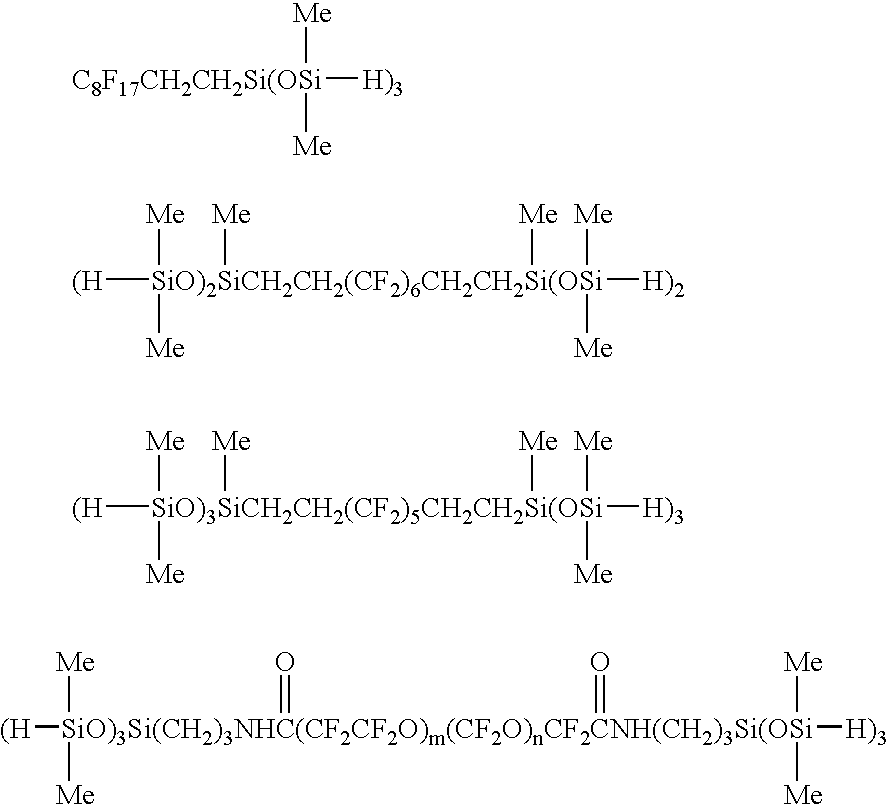Fluorine-containing polymer composition and cured body
a technology of fluorine-containing polymers and compositions, applied in the field of fluorine-containing polymer compositions and to cured materials, can solve the problems of difficult adhesion to other materials or compounds, expensive dicarboxylic acid compounds are required in synthesizing polymers, and poor compatibility with materials or compounds other than perfluoro compounds, etc., to achieve the effect of improving the mechanical characteristics reducing the glass transition point of the cured material
- Summary
- Abstract
- Description
- Claims
- Application Information
AI Technical Summary
Benefits of technology
Problems solved by technology
Method used
Image
Examples
production example
Cured Material Production
Step 1. Synthesis of [(CH3)3COCH2CF2COO]2
[0169]A 100-ml three-necked flask was charged with 50 g of a 20% (by mass) aqueous solution of NaCl, and the contents were cooled to −15° C. Upon addition of 1.05 g of Na2O2, the temperature rose to −10° C. After cooling to −15° C. again, 4.91 g of (CH3)3COCH2CF2COCl was added dropwise. After completion of the dropping, the mixture was stirred for 30 minutes with cooling at −15° C. Then, 5.0 ml of 1,1,2-trichloro-1,2,2-trifluoroethane cooled to −15° C. was added, followed by further 30 minutes of stirring. When allowed to stand, the mixture immediately separated into two layers. The lower white suspension layer was collected. Thus was obtained 6.0 ml of a solution.
[0170]The concentration of the title peroxide was determined by iodometric titration and found to be 134 mg / ml.
Step 2. Synthesis of a Methylene Group-containing Fluoropolymer
[0171]A 100-ml stainless steel reaction vessel was cooled to −50° C. and 4.6 ml of ...
example 1
[0182]To 0.1 g of the liquid polymer (c) heat-treated at 180° C. for 7 hours were added 0.0157 g of a methylhydrosiloxane / dimethylsiloxane copolymer (trademark: HMS-301, product of Gelest, Inc.; molecular weight 1900 to 2000, methylhydrosiloxane content 25 to 30% by mass of the copolymer) and 0.0080 g of a 0.06% platinum catalyst solution in toluene [prepared by 200-fold dilution of PT-VTSC-12.0VTS (trademark, product of OMG Precious Metals Japan Co., Ltd.) with toluene], and the mixture was stirred at 50° C. for 2 hours to give a liquid polymer composition (i). This liquid polymer composition (i) was sticky.
[0183]The liquid polymer composition (i) was sandwiched between two fluororesin films, and the thus-formed sheet was then heated at 150° C. for 1 hour. This heating gave a nonsticky cured material. The cured material obtained was immersed in acetone and it was confirmed that the material was not dissolved but maintained the sheet form. IR measurement of this cured material revea...
example 2
[0184]An acetone solution (also referred to as “coating composition”) of the liquid polymer composition (i) was prepared by dissolving 0.1 g of the liquid polymer (c) heat-treated at 180° C. for 7 hours, 0.0157 g of a methylhydrosiloxane / dimethylsiloxane copolymer [trademark: HMS-301, product of Gelest, Inc.; molecular weight 1900 to 2000, methylhydrosiloxane content 25 to 30% by mass of the copolymer) and 0.0080 g of a 0.06% platinum catalyst solution in toluene [prepared by 200-fold dilution of PT-VTSC-12.0VTS (trademark, product of OMG Precious Metals Japan Co., Ltd.) with toluene] in 1.0 g of acetone.
[0185]The acetone solution of the liquid polymer composition (i) was transferred to a glass dish and heated at 150° C. for 1 hour to give a sheet-like cured material. The solvents acetone and toluene evaporated during the heating. The cured material obtained had elasticity but the stickiness found with the liquid polymer (c) was no more found. The IR spectrum of the cured material o...
PUM
| Property | Measurement | Unit |
|---|---|---|
| temperature | aaaaa | aaaaa |
| viscosity | aaaaa | aaaaa |
| viscosity | aaaaa | aaaaa |
Abstract
Description
Claims
Application Information
 Login to View More
Login to View More - R&D
- Intellectual Property
- Life Sciences
- Materials
- Tech Scout
- Unparalleled Data Quality
- Higher Quality Content
- 60% Fewer Hallucinations
Browse by: Latest US Patents, China's latest patents, Technical Efficacy Thesaurus, Application Domain, Technology Topic, Popular Technical Reports.
© 2025 PatSnap. All rights reserved.Legal|Privacy policy|Modern Slavery Act Transparency Statement|Sitemap|About US| Contact US: help@patsnap.com



